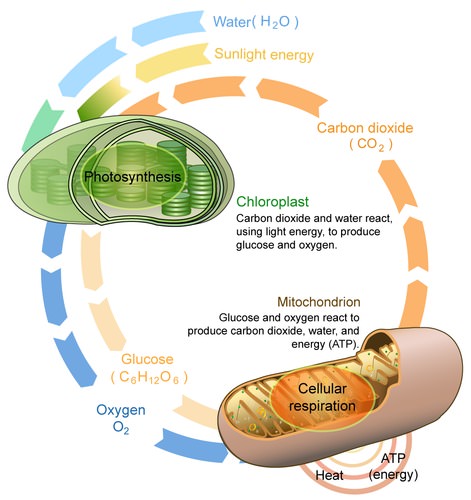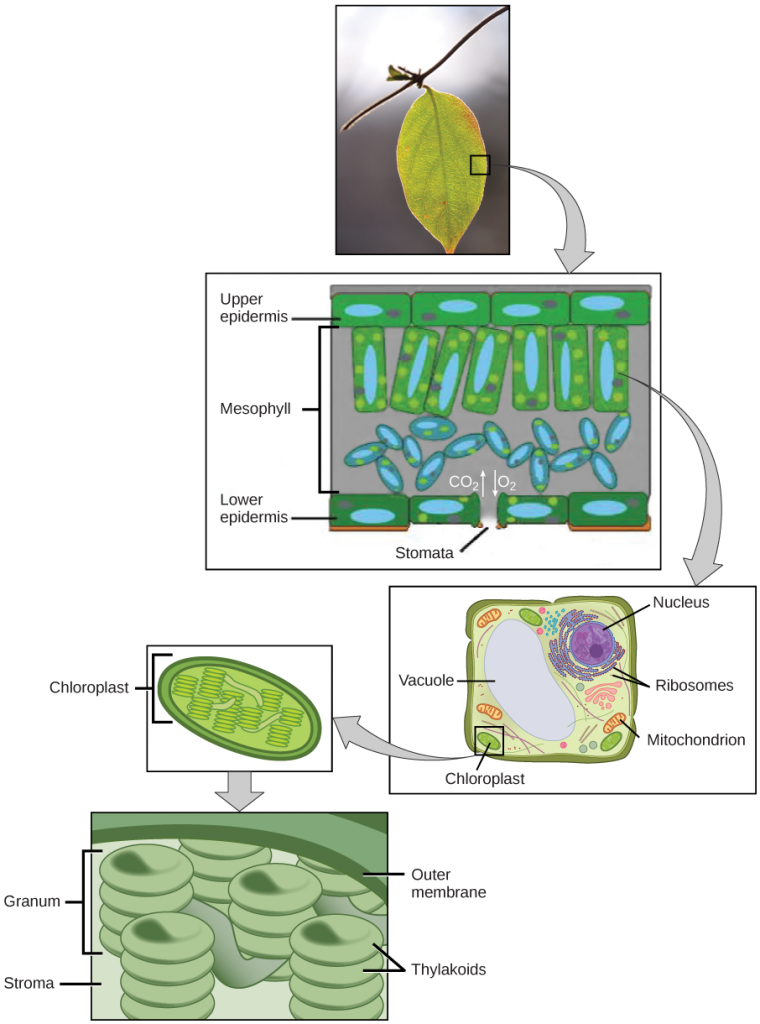5.2 Overview of Photosynthesis
Life runs on chemical energy. Most ecosystems get this energy from photosynthesis. Photosynthesis stores energy from sunlight in the chemical bonds of glucose. Cellular respiration is then used to break the chemical bonds in glucose to release energy and make ATP.

Figure 5.2.1 Description
A diagram comparing photosynthesis and cellular respiration with their respective chemical equations. The top section, labelled ‘Photosynthesis (endothermic) – storing energy in the glucose molecule’ in green text, shows the photosynthesis equation:
6CO₂ + 6H₂O → C₆H₁₂O₆ + 6O₂.
A small sun icon with rays represents the energy input from sunlight.
The bottom section, labelled ‘Cellular Respiration (exothermic) – releasing the energy from the glucose molecule’ in purple text, shows the cellular respiration equation:
C₆H₁₂O₆ + 6O₂ → 6CO₂ + 6H₂O.
A small yellow explosion-like shape labelled ‘energy’ represents the energy released during the process.
The colour-coded text highlights key elements in the equations: carbon dioxide (CO₂) in blue, water (H₂O) in light blue, oxygen (O₂) in red, and glucose (C₆H₁₂O₆) in black.
Not all organisms can make their own food. Organisms are divided into two categories based on how they obtain their chemical energy:
Autotrophs
An autotroph is an organism that can produce its own food. The Greek roots of the word autotroph mean “self” (auto) and “feeder” (troph). Most autotrophs use the energy in sunlight to make food during photosynthesis. Plants are the best-known autotrophs, but others exist, including algae and certain types of bacteria. Autotrophs are also called producers. They produce food for themselves and all other living things (consumers).

Heterotrophs
Energy Flow
Energy flows through an ecosystem. It enters as sunlight and exits as heat. In contrast, chemical elements are recycled within an ecosystem. Photosynthesis uses carbon dioxide (CO2), a gas absorbed from the atmosphere, and water (H2O), which is absorbed from the soil through the roots. Using the energy from sunlight, these molecules are rearranged to form glucose (C6H12O6) and oxygen (O2), a waste product that is released into the atmosphere. The products from photosynthesis are then used in cellular respiration. In the presence of oxygen, the chemical bonds in glucose are broken to release energy, which is harnessed to create ATP. Carbon dioxide and water are then produced as by-products.

Figure 5.2.3 Description
This diagram visually explains how photosynthesis and cellular respiration are interconnected, forming a biological energy cycle that sustains life. Photosynthesis captures solar energy and stores it in glucose, while cellular respiration releases this energy for cellular activities.
Located inside the chloroplast, photosynthesis is depicted as the process where carbon dioxide (CO2) and water (H2O) react using sunlight energy to produce glucose (C6H12O6) and oxygen (O2). The photosynthesis reaction is labelled with green text.
Located inside the mitochondrion, cellular respiration occurs where glucose and oxygen are used to produce carbon dioxide, water, and ATP (energy). The cellular respiration reaction is labelled in orange text.
Circular Flow of Matter and Energy: The image uses arrows forming a continuous cycle to represent the exchange of materials between the two processes. Blue arrows indicate the movement of oxygen and glucose from photosynthesis to cellular respiration. Orange arrows show the transfer of carbon dioxide and water back to photosynthesis.
Sunlight energy is absorbed for photosynthesis, while heat and ATP energy are released during respiration.
Location of Photosynthesis
In plants, photosynthesis takes place primarily in leaves, which consist of many layers of cells and have differentiated top and bottom sides. The process of photosynthesis occurs not on the surface layers of the leaf but rather in a middle layer called the mesophyll. The gas exchange of carbon dioxide and oxygen occurs through small, regulated openings called stomata.
In all autotrophic eukaryotes, photosynthesis takes place inside an organelle called a chloroplast. In plants, chloroplast-containing cells exist in the mesophyll. Chloroplasts have a double (inner and outer) membrane. Within the chloroplast, there are stacked, disc-shaped structures called thylakoids. Chlorophyll molecules are embedded in the thylakoid membrane, a pigment (a molecule that absorbs light) through which the entire process of photosynthesis begins. Chlorophyll is responsible for the green colour of plants. The thylakoid membrane encloses an internal space called the thylakoid space. Other types of pigments are also involved in photosynthesis, but chlorophyll is by far the most important. A stack of thylakoids is called a granum, and the space surrounding the granum is called stroma (not to be confused with stomata, the openings on the leaves).

Figure 5.2.4 Description
A detailed diagram illustrates a leaf’s structure and its internal components, focusing on photosynthesis. At the top, a photograph of a green leaf on a branch is shown, with a small section highlighted for magnification. Below, a cross-section of the leaf displays its layers: the upper epidermis, mesophyll, and lower epidermis. The mesophyll contains chloroplasts, where photosynthesis occurs, and stomata, which facilitate gas exchange (CO₂ intake and O₂ release). Another magnified section highlights a plant cell, showing organelles such as the nucleus, vacuole, ribosomes, mitochondrion, and chloroplast. Further zooming in, a chloroplast diagram is displayed, labelling its internal structures, including the outer membrane, stroma, granum, and thylakoids, where light-dependent photosynthesis reactions occur. Arrows indicate the progressive zooming in from the whole leaf to its cellular and organelle components.
Stages of Photosynthesis
Photosynthesis occurs in two stages: the light-dependent reactions and the Calvin cycle. In the light-dependent reactions, which take place at the thylakoid membrane, chlorophyll absorbs energy from sunlight and then converts it into chemical energy using water. The light-dependent reactions release oxygen from the hydrolysis of water as a byproduct. In the Calvin cycle, which takes place in the stroma, the chemical energy derived from the light-dependent reactions drives both the capture of carbon in carbon dioxide molecules and the subsequent assembly of sugar molecules. The two reactions use carrier molecules to transport the energy from one to the other. The carriers that move energy from the light-dependent reactions to the Calvin cycle reactions can be considered “full” because they bring energy. After the energy is released, the “empty” energy carriers return to the light-dependent reactions to obtain more energy.
Exercises 5.2.1
Text Description
- The rate of photosynthesis will slow down
- The rate of photosynthesis will speed up
- The rate of photosynthesis will stop
- The rate of photosynthesis will stay the same
- Glucose and oxygen
- Water and carbon dioxide
- Water and oxygen
- Glucose and carbon dioxide
- Thylakoids exist as a maze of folded membranes
- Thylakoids contain chlorophyll
- The space surrounding thylakoids is called stroma
- Thylakoids are assembled into stacks
- The sun and eating other organisms
- Eating other organisms
- The sun
- Simple chemicals in the environment
“4.9 Energy Needs of Living Things” from Human Biology by Christine Miller is licensed under a Creative Commons Attribution-NonCommercial 4.0 International License, except where otherwise noted.



